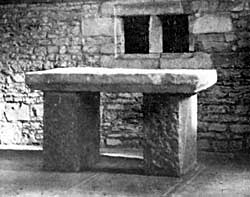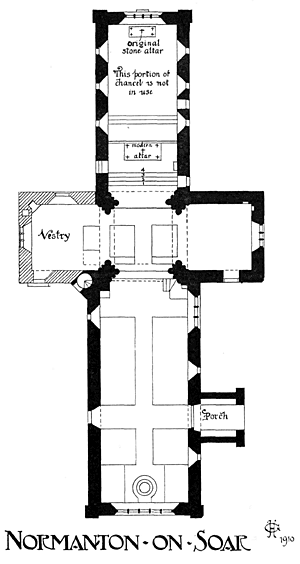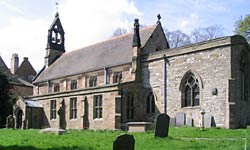THE CHURCH AT NORMANTON-ON-SOAR.
BY THE REV. A. M. Y. BAYLAY.

NORMANTON-ON-SOAR. Photograph by E. L. Guilford.
No part of this church shews any trace of architecture older than what is called the Early English style, and it is not improbable that whatever church existed here previously was of timber. The fact that in Domesday Book no church is mentioned here does not prove anything, as the enumeration of churches in the Domesday Survey was far from complete.
The oldest part of the existing church is the tower, erected about the beginning of the 13th century, and the fact of the builders beginning with a central tower seems to indicate that their church did not occupy precisely the same site as that previously existing. The work of building the church seems to have gone steadily on, with no great intervals between the various parts. The north side is, I think, by a different hand from the south, and perhaps a little earlier: the west window somewhat later, and the east window later still, but all within the first half of the 13th century,—as is also the spire, which is later than the tower, and probably not intended by the original builder. Its weight has somewhat crushed the tower, and created a need for additional buttressing on its west side, especially at the north-west corner, where a very large buttress has been built, and afterwards partly removed.
The only piece of 14th century work is the large "low-side "window in the south wall of the chancel;—in this case undoubtedly a reading window, to give additional light to the rector's stall. The lower compartments would not contain any stained glass, and perhaps were not originally intended to be glazed at all, but closed with shutters.

STONE ALTAR, NORMANTON-ON-SOAR. Photograph by E. L. Guilford.
In the 15th century the important step was taken of raising the walls of the nave, and introducing an open roof of lower pitch than before. The course followed was, I believe, unique. The walls were raised with a storey of timber work, to which the pendent posts of the new roof were attached. Probably this timber construction was thinner than the stone walls below, and had a set-off outside, covered with lead to keep the rain out of the tops of the walls. A trace of this can be seen on the south wall, towards its eastern end. In the 18th, or late in the 17th century, the outer sides of the timber storey have been faced with brick work (apparently not all of one date) flush with the stone walls below; and four small windows with wooden frames constructed. It is doubtful if the timber storey had originally any windows.
Let me pause here to express my fervent hope that nothing to be done here under the name of "restoration," will in any degree interfere with the preservation of this most interesting feature,—unparalleled, so far as I know, in any church in the kingdom. Repair no doubt is needed, but repair neither need, nor should, mean the destruction of any portion of the existing work, whether of the 15th or the 18th century. The timber roof is of excellent design:—indeed, one of the best points about the church.
To the 15th century belong also three other things noticeable in the church:—(1) the font, of somewhat unusual design:—(2) the large Perpendicular window in the south wall of the nave, doubtless designed to throw light on the "Jesus" altar which would stand in that corner:—(3) the lowering of the pitch of the chancel roof, and the addition of stone parapets and gargoyles to its walls.
And here let me remark that, of all the foolish things commonly done by the "restorer," one of the most foolish is the replacing of these low pitched mediaeval roofs by what he calls the "original high pitch." He not only destroys the interest of the building and obliterates its history, but almost invariably produces a most unpleasing effect,— of which, I think, we have an example no further off than Long Whatton. The 15th century men knew what they were doing, and their lower pitched roofs give an outline to the building full of repose and dignity. This is conspicuously true of this church of Normanton-on-Soar, and any unprejudiced person who looks carefully at its exterior will be convinced how greatly it would be spoilt by the intrusion of modern high pitched roofs to the nave and chancel.
The 15th century doubtless saw also the erection of a rood-loft, which probably occupied the whole space of the tower, having screens both on its eastern and western sides. Over the latter would be placed the rood. The partial removal of the large buttress on the north side may have been connected with the setting up of this loft. For the plan of the church made in 1889, just before its restoration by Mr. Weatherley, shews a trace of a winding stair adjoining the north-west buttress of the tower, the entrance to which must have been from the destroyed north transept. This would probably form the approach to the west side of the rood-loft. The site of this old stair is occupied by the modern winding stair which now gives access to the belfry.
The south porch is an addition or re-construction of the 17th or 18th century. The later history of the church is sad enough. The north transept was allowed to fall down, and the arch leading into it walled up. The south transept was walled off and secularized:—being used at one time as a joiner's shop, and, later, for a school. The western arch of the tower was also walled up, with the exception of a small doorway in the middle, over which were the splendidly executed royal arms in plaster work, dated 1683,—now placed on the north wall of the nave.
In 1889 the church was restored from designs by Mr. Weatherley. The north transept was re-erected, and the tower arches opened out. At the same time, the altar was placed halfway along the chancel, on an inappropriate flight of stone steps. Much very necessary repair was at the same time carried out, which, in fact, saved the church from becoming a ruin : and the only things connected with this restoration which the antiquary can regret are the arrangement of the altar already alluded to, and the removal of the good old benching of the nave,—some remains of which can be seen in the transepts and behind the altar. From the architect's drawings it appears he intended to introduce a new clerestory of his own designing, but happily this was not carried out.
In 1897 the four bells, two of which, were cracked, were re-cast.

To come now to the particular parts of the church. In the nave, notice the remarkable south door. The jambs are of the Early English style, and have had two shafts in each: but the arch has been re-constructed later, and does not fit on properly to the jambs. When and why this was done it is hard to imagine: I think it not improbable that the original arch was semi-circular, as in the case of the north doors of both nave and chancel. The semi-circular form in these doorways, and in one small window in the north side of the nave, does not indicate a Norman date: it was a form frequently retained in the Early English style. The little window in question has the dog-tooth ornament under the hood.
In the tower, the western belfry window is plainer in style than the others, and higher up: it has probably been re-constructed and raised, so as to give room for the high pitched roof originally put on the nave, which seems to have been erected some few years later than the tower. The arches supporting the tower are fine specimens of their style.
On one jamb of the eastern arch the nail-head ornament appears. In the south-east corner of the south transept are three small recesses in the wall, which Mr. Godfrey considers to have been the piscina, credence, and aumbry belonging to the altar which no doubt once stood here.
The chancel is of great interest, and of unusual size for its date, reminding us in this respect of that at Shelford. There must have been a reason for giving it so long an extent, at a date when choirs in parish churches were, as a rule, composed of but few persons. Perhaps there were some occasions in the year when a party of monks from Durham were present and took part in the service, since the Prior and Convent were patrons of the benefice, and drew certain revenues from the place.
On the outside of the chancel, notice the quaint fancy of the masons, in introducing the dog-tooth ornament under the hood of one lancet window only on the south side. The low buttress under the east window has been made unusually broad, not without a reason, as we shall presently see. On the north side, walled up, is a finely moulded priest's door, with semi-circular head,—a form much affected by the builders of this church. A corresponding door on the south has been destroyed in making the 14th century low-side window. In modern times a square-headed south doorway has been made, further to the east. I cannot say why there should have been two doors to the chancel, where there was no division of the tithe:—unless it be that the Prior and Convent of Durham claimed the right to separate access. Inside the chancel, the chief feature of interest is an ancient altar slab, now resting on two rough stone supports; but originally, no doubt, on one solid mass of masonry. The consecration crosses can be distinguished. There is no loculus for relics; and this altar has either been consecrated without relics,—as was very commonly the case in England— or they have been enclosed in the substructure. From its small size, this has certainly not been the high altar, but has stood in one of the chapels. A recess in the north wall has, I think, been the Easter sepulchre. Behind the altar are a couple of large aumbries in the east wall, space for them being ingeniously provided by the wide buttress above mentioned. To the south is a piscina, but the projecting part of the bowl has been cut away. The east window is a good specimen of early tracery, shewing an advance on the simple grouped lancets of the west front. But the somewhat awkward handling of the openings speaks of an art still in its infancy.
The fullest possible information about the various gravestones and tablets contained in the church will be found in Mr. Godfrey's "Churches of the Hundred of Rushcliffe," to whose painstaking labours I owe a great deal. In his pages, we see the church previous to restoration, almost as clearly as if it was before our eyes.
There seems some doubt about the dedication of this church : Mr. Godfrey assigns it to St. Mary, on the authority of ancient wills preserved at York. But the dedication currently accepted is to St. James-the-greater,—and the rector tells me that St. Stephen has also been mentioned as the patron saint.
 St Helen's church,
West Leake (photo by A Nicholson, 2006).
St Helen's church,
West Leake (photo by A Nicholson, 2006). Leaving the church, the party went on to luncheon at the Plough Inn, and soon after 1 p.m. a start was made for West Leake, where the church of St. Helena was visited. No paper was read here; but the church is interesting on account of its Early Decorated work, and its extremely long nave, measuring only about 15in. less than 20yds. in length, is remarkable. The church consists of a chancel supported by diagonal buttresses; a nave of five bays with octagonal pillars; a north transept of great width compared with its length, and opening into the nave by a pointed arch which is doubly chamfered; a south aisle which has been rebuilt, and the east end of which contains a stained glass window to the memory of the Rev. John Bateman, who was rector of East and West Leake for forty-six years, and died in 1882. The west wall of the nave, which has also been rebuilt, contains a pointed window of three lights, and is surmounted by a modern bell turret which has two 16th century bells founded by Thomas Hedderley. There are three monumental effigies of some interest; one, within an Early English canopy, of a lady, probably a member of the Leake family, which lies in the north transept under an archway in the north wall; a second under a recess in the north wall of the chancel, and of Early English character and date; a third in a recess in the south wall of the south aisle, also of considerable antiquity. There is a goodly number of monuments in the church, the chief being those of Richard Mansfield 1624, Thomas Mansfield 1706, Thomas Mansfield 1741/2, Robert Hemington 1772, Rev. Edward Ellis 1795, Rev. Edward Bigland 1650.1
(1) For further details of this and other churches in the Rushcliffe Hundred, see Mr. J. T. Godfrey's book. "Notes on the Churches of Nottinghamshire—Hundred of Rushcliffe."
